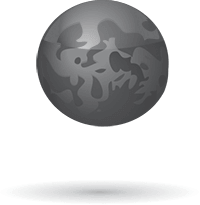The neighborhood I live in was once part of a massive inland sea which is where the fossil I found in my yard used to reside. We were new to Wimberley and had never seen such a thing and thought about informing a museum or university. Then a friend showed us her collection, accumulated from growing up in the area. So my discovery was not a national treasure after all, but it was rare enough to get excited about.
Some research revealed it to be a calcified remnant of a Gastropod, an ocean dwelling snail about the size of a tennis ball. It lived during the Cretaceous period, around 80 to 100 million years ago. One side of its body has a spiral shape that is smaller at the top than the bottom. Turn it over and it’s smooth and bulbous, and not nearly as enticing. The thing about finding a prehistoric fossil is you immediately want to find another one. My backyard ends at the bottom of a canyon with a mostly dry creek bed. While scanning most of the ten million or so surface rocks that came with the property I did find some more fossils. Some were broken or eroded out of shape, but a few were in excellent condition for something so old. I found a bivalve clam with its shells closed and another that died with its halves open, forming the shape of a heart. I found invertebrates that look like modern day shells and some less familiar forms that must have gone out of style long ago.
Some connected events had to occur in order for me to find the fossils. South America collided with North America, creating mountain ranges, canyons and a new continent called Pangaea. More seismic activity caused the coastal plains to bend downward and the water that covered it flowed downhill to form what we now call the Gulf of Mexico. The bedrock of what was to become the Texas hill country encompassing Wimberley remained fairly stable, and most of the water that covered it filtered through the porous limestone to fill the massive Edwards and Trinity Aquifers. The absence of so much surface water revealed the canyons and valleys that make up the Texas Hill country. Rainfall filled in the depressions that formed our lakes, and the limestone filtered it to make the water clear and pristine. One of the geologic anomalies created by the shifting earth is the Balcones Fault, which more or less parallels Interstate 35 from Waco to San Antonio, and continues some distance in both directions. There is a public entrance into a section of the fault in Wonder World cave in New Braunfels. You can see how the earth fractured and separated into jagged walls and how if you could reverse the process the rock could fit back together into a reasonably solid piece. In some parts of the cave the ceiling is the mud floor of the ancient sea bed, seen from the bottom. It is littered with ancient sea creatures, including some of the same species I found in Wimberley. The ceiling looks like an ancient abstract freeze of prehistoric organisms.
The fossils I found in my back yard were formed when the creatures died and they were covered in silt that hardened. The creature, including its hard exoskeleton eventually dissolved, creating a mold. Minerals filled the mold and hardened into a replica of the original creature. Over the eons, the earth that covered the fossil eroded and left it in a convenient place for me to find. Eureka! Finding fossils is just a matter of being in the right spot and the right epoch at the correct layer of geological strata while looking down.
Jim McJunkin has been a photographer for over 50 years and his work has been shown in a number of art and photography shows around the country. He has work in the permanent collection at the National Vietnam Veterans Art Museum in Chicago, Illinois, and has authored several photography- related books. Jim and his wife Beth have lived in Wimberley for 20 years.







